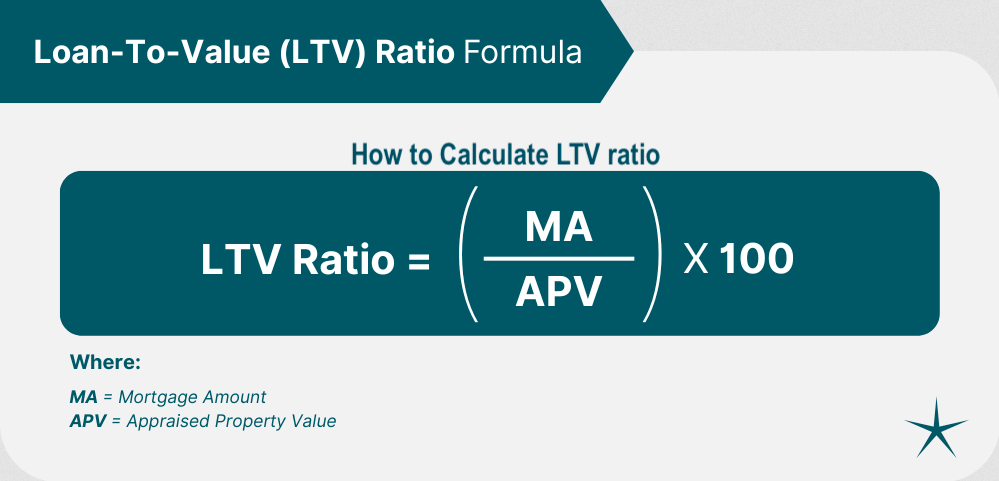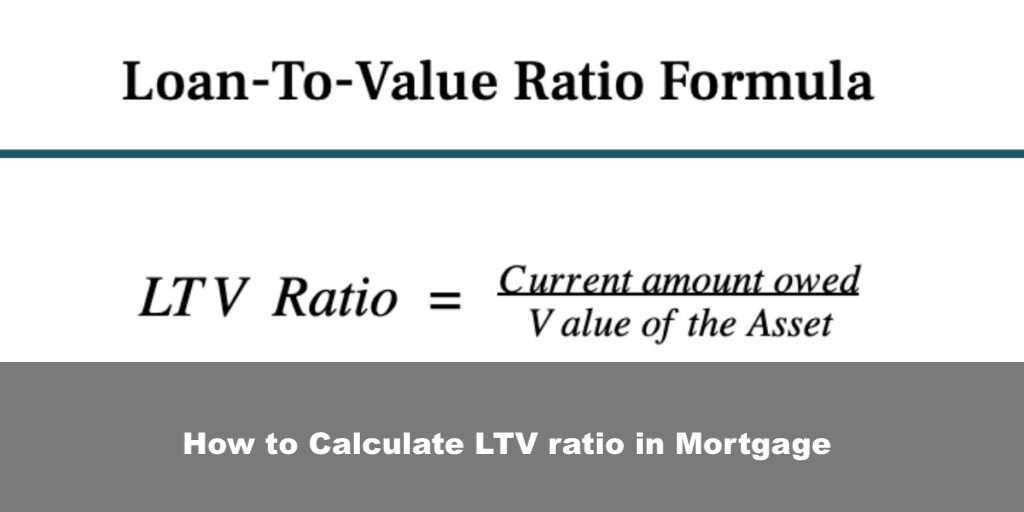Understanding Loan-to-Value Ratio (LTV) Requirements, and knowing how to calculate LTV in Mortgage is important to homeowners. If you want to buy a house and are getting a loan to help, there are many important numbers to think about, like interest rates, closing costs, and how much debt you have compared to your income. One of the important numbers is called your loan-to-value ratio, or LTV.
Your lender will pay close attention to this number when deciding if they should give you the loan: It decides if you’ll get approved and how much money they’ll give you. Let’s learn more about what the LTV means.

What is Loan-to-Value Ratio (LTV)?
The loan-to-value ratio, or LTV, is a number that compares how much money you’re borrowing to the actual value of the house you want to buy. LTV stands for Loan-to-Value ratio. This ratio represents the proportion of the money you’re borrowing (referred to as the loan principal) divided by the appraised value of the property you intend to purchase.
When you submit a mortgage application, the lender takes your LTV ratio into account to assess your eligibility for the loan. Additionally, if you’re approved for the loan, the lender will factor in your LTV to determine the loan amount and the interest rate associated with it. This means that, the LTV ratio helps lenders gauge the financial risk of the loan by considering the balance between the borrowed amount and the property’s value.
Why is LTV Important?
Lenders care about the LTV because it helps them understand how risky it is to give you the loan. If you’re borrowing a lot compared to the value of the house, it could be risky for them. If the value of the house drops, they might not get all their money back.
From the standpoint of a lender, a lower Loan-to-Value (LTV) ratio is preferable to a higher one. This is because a lower LTV ratio signifies that a potential borrower is capable of providing a more substantial down payment, which translates to a reduced need for borrowing a significant amount of money. In essence, a lower LTV ratio is indicative of a borrower who has a greater stake in the property upfront, thereby reducing the lender’s perceived risk and making the loan arrangement more favorable.
How to Calculate a Loan-to-value Ratio
To determine your LTV ratio, follow these steps:
- Begin by subtracting your down payment from the appraised value of your home.
- Divide the result from step 1 by the appraised value.
- Multiply the outcome from step 2 by 100.
The formula can be represented as:
[Appraised value – Down payment / Appraised value] x 100 = LTV ratio

For instance, let’s say you’re making a $50,000 down payment on a property valued at $500,000, resulting in a mortgage of $450,000. Using the formula, your LTV ratio would be calculated as follows: [(500,000 – 50,000) / 500,000] x 100 = 90%
In this scenario, your LTV ratio would be 90 percent. This figure provides insight into the proportion of your property’s value that you’re financing through the mortgage.
Helpful Guides
- What is Negative Amortization in Mortgage
- Mortgage Points: What Are They And How do They Work?
- Rebuild Your Credit Score After Repossession for Missing Payments
How Does LTV Affect You?
The LTV affects whether the lender will say yes to your loan. If your LTV is too high, they might not approve you. And if they do approve you, they might give you less money than you asked for.
Example:
Let’s say you want to buy a house that costs $100,000. You have $20,000 saved, so you need a loan of $80,000. The LTV in this case is 80%, because your loan is 80% of the house’s value.
If the lender isn’t comfortable with an 80% LTV, they might say you can only borrow $70,000 instead. This means you’d need to find a way to come up with more money for the down payment.
Why do Borrowers lenders review your LTV during the mortgage process?
Before a bank or lender makes a decision regarding your mortgage application, their underwriting department needs to ensure that you possess the means to repay the loan. The Loan-to-Value (LTV) ratio is an essential aspect, but assessing your ability to manage the “L” component of the equation demands a more comprehensive evaluation.
In addition to LTV, lenders delve into your debt-to-income (DTI) ratio to gain insights into your financial capabilities. This evaluation comprises two categories: the front-end ratio and the back-end ratio.
The front-end ratio, often referred to as the “housing ratio,” dissects your total monthly mortgage payment—covering principal, interest, taxes, and insurance (PITI)—and divides it by your monthly income.
Helpful Insights
- 10 Types of Government Grant Money you Should Apply for Today
- U.S. Bank Mortgage: Mortgage Types, It’s Term’s and how it Works
- What is Mortgage Home Loan, Types and Process of Securing it?
- What’s Interest-Only Mortgage: How It Works and it’s Pros and Cons?
- What is Mortgage Loan Rates Today: Compare Rates Up-rise and Drops
- Advantages and Disadvantages of Joint Mortgage Loan for Family Home
Example
For instance, if your monthly mortgage payment is $3,000 and your monthly income is $12,000, your front-end ratio would be 25 percent.
However, your mortgage payment is just one facet of your financial obligations as a homeowner. You may also have commitments like a car loan or student loans. To assess your complete financial picture, the back-end ratio considers all your monthly debt responsibilities, including your mortgage payment, and divides this sum by your monthly income. This comprehensive evaluation provides lenders with a more comprehensive understanding of your financial capacity and guides their decision-making process.
Suppose your monthly earnings amount to $6,000. With a monthly mortgage payment of $1,500 and additional monthly debt responsibilities totaling $1,300, your back-end or Debt-to-Income (DTI) ratio would amount to 47 percent.
Considering the interplay of your mortgage’s Loan-to-Value (LTV) ratio and the front- and back-end DTIs, it’s crucial to recognize that if the lender perceives you as a higher financial risk, you might find yourself facing a higher interest rate. This outcome translates to increased payments over the duration of the loan, ultimately leading to a higher total cost over the loan’s lifespan. The lender’s assessment of your overall risk profile significantly influences the terms of your loan and its associated financial implications.
Related: How to Calculate Debt-to-Income Ration
Loan-to-value Ratio Requirements by Type of Home loan
| Type of Loan | LTV maximum |
|---|---|
| Conventional loan* | 80% |
| FHA loan | 96.5% |
| VA loan | 100% |
| USDA loan | 100% |
| Refinance* | 80% |
| *Without private mortgage insurance (PMI) | |
Here’s a breakdown of good Loan-to-Value (LTV) ratios for various types of loans:
- Conventional Loan: Typically, a favorable LTV ratio for a conventional loan is around 80%. This means you can make a 20% down payment, eliminating the need for private mortgage insurance.
- FHA Loan: To secure an FHA loan, an LTV ratio of approximately 96.5% is generally acceptable. It’s important to note that regardless of your down payment size, mortgage insurance is required for FHA loans.
- VA Loan: For service members or veterans, a VA loan permits a 100% LTV ratio, which essentially means you can secure a loan with no down payment. However, you must meet other approval criteria to qualify.
- USDA Loan: The U.S. Department of Agriculture extends the opportunity for certain low- and moderate-income homebuyers in rural areas to obtain approval with a 100% LTV ratio.
- Refinancing: If you’re considering refinancing your existing mortgage, lenders typically prefer to see an LTV ratio of 80% or lower, which signifies a minimum of 20% equity.
These LTV ratio benchmarks serve as guidelines for different loan types and scenarios, helping you gauge your financial standing and potential eligibility based on your down payment and equity.
What is Combined Loan-to-Value (CLTV)?
When you’re considering a second mortgage while already having an existing one, the lender will assess the Combined Loan-to-Value (CLTV) ratio. This comprehensive calculation accounts for all outstanding loan balances on the property, encompassing both the existing first mortgage and the new second mortgage.
For example, imagine you have an outstanding mortgage balance of $500,000 on a property appraised at $1,000,000. You plan to secure a $60,000 Home Equity Line of Credit (HELOC) for a kitchen renovation. Here’s a breakdown of the Combined LTV (CLTV) ratio:
($500,000 + $60,000) / $1,000,000 = 56% CLTV
This indicates a CLTV ratio of 56 percent, signifying the combined impact of your first mortgage and the new HELOC on your property’s value.
If you already have a Home Equity Lines of Credit (HELOC) and are contemplating an additional loan, your lender might examine a comparable metric known as the Home Equity Combined Loan-to-Value (HCLTV) ratio. Unlike the CLTV, the HCLTV considers the entire amount of the HELOC against your home’s value, not solely the funds drawn from the line of credit. This calculation provides lenders with a comprehensive view of your home’s equity situation when assessing your eligibility for another loan.
Difference Between LTV and CLTV
LTV and CLTV works in the same way. Both of them reflect the proportion of equity present in your home in relation to the outstanding debt. The divergence lies in their scope of consideration: LTV pertains exclusively to your primary mortgage, whereas CLTV encompasses your initial mortgage and any subsequent home-related debts, like a Home Equity Line of Credit (HELOC) or a home equity loan.
For correct figure in your calculation and comparison, you can Mortgage calculator from Bankrate, Business Insider, Wells Fargo, and so on. If you make use of these tools helps you to know your CLTV. From there, you can then assess it against your fundamental LTV, aiding you in understand the financial landscape of your property ownership.
What is a Good LTV – Loan-to-value Ratio?
The optimal Loan-to-Value (LTV) ratio is dependent on the specific criteria set by the lender and the type of loan being considered. From your perspective as the borrower, an advantageous LTV ratio would entail a substantial down payment and a reduced borrowing amount.
As a general principle, a lower LTV ratio is more favorable, as it minimizes the risk of falling into a situation where your mortgage surpasses the value of your home—commonly referred to as being “underwater” on your mortgage. This safeguards you from potential losses in case home values experience a significant decline.
How to lower your Loan-to-value Ratio (LTV)
Reducing your Loan-to-Value (LTV) ratio can be achieved through two main avenues:
- Increasing Down Payment: By setting aside more funds for a larger down payment, you directly lower the amount you need to borrow. This results in a reduced LTV ratio and potential benefits like avoiding mortgage insurance costs.
- Opting for a More Affordable Property: Choosing a less expensive property can naturally lower the overall borrowing amount, leading to a more favorable LTV ratio.
For example, look at a scenario where you decide on a $500,000 home instead of the previous $1,000,000 one. With a $100,000 down payment, your resulting 80 percent LTV ratio not only helps avoid mortgage insurance costs but also positions you closer to swiftly paying off the loan.
For you to know how much house you can realistically afford, you can make use of an online Home loan calculator. This tool empowers you to make informed decisions by evaluating your financial capacity and potential loan scenarios.
Related: 5 Steps to Lower Your Credit Card Interest Rate
Conclusion
In conclusion, the loan-to-value ratio (LTV) is an important number when you’re applying for a mortgage to buy a house. It affects whether you’ll get approved for the loan and how much money you can borrow. It’s crucial to understand the LTV and work on ways to improve it if needed.
Helpful Mortgage Guide and Overview:
- Minimum Down Payment on a Home Loan
- Refinancing Your Home: The Pros and Cons
- What is Conforming Loans, Rates and Mortgage
- Non-conforming loans rate, Underwriting Guidelines
- Jumbo Loan and Interest Rates: How to Qualify for it
- FHA Loan insured by the Federal Housing Administration
- VA Home Loan Buyer’s Guide, Program Benefits, Eligibility
- USDA Home Loan by United States Department of Agriculture
- Government-backed Mortgage Home Loan for First Time Buyers
- How to Calculate Debt-to-income Ratio for a Mortgage Application







